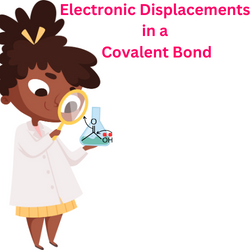
To understand the outcomes of chemical reactions, you must learn about electron excess, electron loss, electron stability, whether bonds share electrons equally or not, where they are displaced, how they are displaced, and what displaces them.
The chapter addresses all these concerns and provides a masterclass on electron displacements driving reactions, namely Inductive, Resonance, Electronegativity, and Hyperconjugation effects.
Chapter Electronic Displacements in a Covalent Bond covers:
- Electronegativity- Introduction
- Factors Affecting Electronegativity- Atomic number, Atomic size, Shielding effect
- Factors Affecting Electronegativity-s-orbitals, Oxidation state, Group electronegativity
- Application of Electronegativity in Organic Chemistry
- Physical Properties Affected by Electronegativity
- Inductive effect- Introduction, Types, Classification, and Representation
- Factors Affecting Inductive Effect- Electronegativity
- Factors Affecting Inductive Effect- Bonding Order and Charge
- Factors Affecting Inductive Effect- Bonding Position
- Application of Inductive Effect- Acidity Enhancement and Stabilization of the counter ion due to -I effect
- Application of Inductive Effect-Basicity enhancement and stabilization of the counter ion due to +I effect
- Application of Inductive Effect-Stability of the Transition States
- Application of Inductive Effect-Elevated Physical Properties of Polar Compounds
- Is the Inductive Effect the same as Electronegativity?
- Resonance- Introduction and Electron Delocalization
- Partial Double Bond Character and Resonance Hybrid
- Resonance Energy
- Significance of Planarity and Conjugation in Resonance
- p-orbital Electron Delocalization in Resonance
- Sigma Electron Delocalization (Hyperconjugation)
- Significance of Hyperconjugation
- Resonance Effect and Types
- Structure Drawing Rules of Resonance (Includes Summary)
- Application of Resonance
- Introduction to Covalent Bond Polarity and Dipole Moment
- Molecular Dipole Moment
- Lone Pair in Molecular Dipole Moment
- Applications of Dipole Moment
- Formal Charges- Introduction and Basics
- How to Calculate Formal Charges (With Solved Examples)
- Difference between Formal charges and Oxidation State